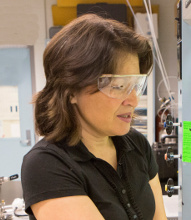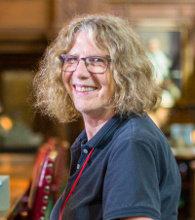
The 2014 MacArthur Fellows
September 19, 2014 The John D. and Catherine T. MacArthur Foundation has just announced its 2014 Fellows Class. The 21 Fellows in this year's class (down from 24 last year) includes six people working in STEM fields, plus an historian of science and technology.[1] Unlike most prizes, which are awarded for accomplishment, the MacArthur Fellowships are awarded for potential. The stated purpose of the fellowships is to allow the fellows an opportunity to "exercise their own creative instincts for the benefit of human society." This year's fellows receive a "no strings attached" award of $625,000, which is paid out in equal quarterly installments over five years.[2] There are some familiar names in science among past years' fellows, as listed, below.• J. Roger Angel (1996), an astronomer who designs innovative telescopes.A biographical note for each of this year's STEM-field recipients appears below. Clicking on a photograph will take you to the thumbnail biography in the text.
• Timothy Berners-Lee (1998), the computer scientist who invented the World Wide Web.
• Mitchell J. Feigenbaum (1984), a mathematical physicist who became interested in chaos theory and discovered the Feigenbaum constants.
• Margaret Joan Geller (1990), an astrophysicist and co-discoverer of the Great Wall.
• Paul Ginsparg (2002) a physicist who started the arXiv physics preprint archive.
• Claire Gmachl (2005), an optical engineer known for the development of quantum cascade lasers and novel optical devices.
• John J. Hopfield (1983) a physicist best known for the Hopfield Neural Network.
• Julia Robinson (1983), a mathematician known for her work on Hilbert's Tenth Problem, which involves Diophantine equations.
• Richard M. Stallman (1990), a computer scientist who started the free software movement. He created the GNU Project and the Free Software Foundation.
• Andrew J. Wiles (1997), a mathematician who proved Fermat's Last Theorem.
• Frank Wilczek (1982), a physicist who elucidated some properties of the strong nuclear force. Wilczek shared the 2004 Nobel Prize in Physics.
• Edward Witten (1982), a physicist working on String Theory. Witten was awarded the Fields Medal, the mathematics equivalent of a Nobel Prize, in 1990.
• Stephen Wolfram (1981), a computer scientist and physicist famous for his work on cellular automata and creation of the Mathematica computer program. Wolfram is also the author of the controversial book, "A New Kind of Science."
 |
 |
 |
 |
 |
 |
 |
Seven members of the MacArthur 2014 Fellows Program. Left to right by row, top row, Danielle Bassett, Tami Bond, Craig Gentry; middle row,
Mark Hersam, Pamela O. Long, Jacob Lurie; bottom row, Yitang Zhang. Photos licensed under a Creative Commons license, Courtesy of the John D. & Catherine T. MacArthur Foundation. |
|
Physicist, Danielle Bassett, (Age 32; Ph.D., University of Cambridge, 2009), was a postdoctoral associate and fellow at the University of California, Santa Barbara, from 2009-2013 before joining the faculty of the University of Pennsylvania as the Skirkanich Assistant Professor of Innovation in the Department of Bioengineering. Bassett applies the concepts of network theory and complex systems theory to theories of the human brain. She analyzes the interactions among neurons in different parts of the brain while a person performs different tasks. By using brain imaging techniques, Bassett has been able to predict a person's ability to learn. Her work will enable better diagnostics and treatment of brain injuries. Her interdisciplinary research has been published in such diverse journals as the Proceedings of the National Academy of Sciences, Physical Review E, and Chaos. Tami Bond
Environmental engineer, Tami Bond. (Age 50; Ph.D., University of Washington, 2000), was a postdoctoral associate (2000–2002) at the NOAA/Pacific Marine Environmental Laboratory from 2000-2002, and a visiting scientist at the National Center for Atmospheric Research from 2002-2003, before joining the faculty of the University of Illinois at Urbana-Champaign as a professor in the Department of Civil and Environmental Engineering and affiliate professor in the Department of Atmospheric Sciences. Bond's research centers on the global effects of black carbon emission on climate and human health. I wrote about black carbon in a previous article (Paint it Black, February 13, 2013). Bond has done laboratory work on the optical and physical properties of black carbon. She and her colleagues have analyzed the extent of black carbon emission from sources such as cook stoves and kerosene lamps. She has published in the Journal of Geophysical Research, as well as the Proceedings of the National Academy of Sciences and elsewhere, and her work has been cited by global policy organizations, such as the World Bank. Craig Gentry
Computer scientist, Craig Gentry (Age 41; Ph.D., Stanford University, 2009), was an intellectual property lawyer from 1998-200, and then a senior research engineer for DoCoMo USA Labs from 2000-2005. Gentry is presently a research scientist in IBM's Cryptography Research Group at its Thomas J. Watson Research Center. His cryptographic work involves techniques that allow computation of encrypted data without prior decryption. As an example of this, an individual's taxes could be calculated from his encrypted financial data. In 2013, Gentry and his colleagues devised the first example of cryptographic software obfuscation, a way to hide the source code of computer programs while keeping their functionality intact. I referenced one of Gentry's papers in a previous article (Obfuscated Software, August 14, 2013). Gentry has published papers in many computer science and cryptography journals and at many conferences. Mark Hersam
Materials scientist, Mark Hersam (Age 39; Ph.D., the University of Illinois at Urbana-Champaign, 2000), is a professor of materials mcience and director of the Materials Research Science and Engineering Center at Northwestern University. He is also the Bette and Neison Harris Chair in Teaching Excellence. Hersam's research interest is nanomaterials, especially in the area of hybrid organic-inorganic materials. He investigates the electrical and optical properties of carbon nanotubes and graphene. Hersam developed density gradient ultracentrifugation as a way to fractionate carbon nanotubes, which he studies with advanced scanning tunneling microscopy techniques. Hersam has published in many materials journals, including Nature Nanotechnology, Advanced Materials, Nano Letters, and ACS Nano. Pamela O. Long
Historian of science and technology, Pamela O. Long (Age 71; Ph.D., the University of Maryland, College Park, 1979), now an independent historian of science and technology, had a career spanning many institutions, including Princeton University and the National Humanities Center. Long investigates how various factors, including trade secrecy and patronage, affected the interactions of scholars, artisans, architects, and engineers in the early modern period. Long's 2001 book, "Openness, Secrecy, Authorship: Technical Arts and the Culture of Knowledge from Antiquity to the Renaissance," investigates the openness of scientific and technical information. She is likewise interested in the affect that artisans, craftsmen, and engineers have had on scientific methods. She is now researching the cultural history of engineering in Rome from 1557-1590. Jacob Lurie
Mathematician, Jacob Lurie (Age 36; Ph.D., the Massachusetts Institute of Technology, 2004), is a professor of mathematics at Harvard University. He was a Harvard postdoctoral fellow from 2004-2007, and he was at MIT from 2007-2009 before joining the Harvard faculty. Lurie's main interest is algebraic geometry, in which he seeks to replace the role of sets by topological spaces. Lurie is a prolific author, having written two books, Higher Topos Theory (2009) and Higher Algebra (2011), and numerous papers. Yitang Zhang
Mathematician, Yitang Zhang (Age 59; Ph.D., Purdue University, 1991), is a professor of mathematics at the University of New Hampshire. Prior to this, he worked as a delivery man and as an accountant before becoming a lecturer at New Hampshire in 1999. Zhang, about whom I wrote in a previous article (The Twin Prime Conjecture, June 3, 2013), proved that there are an infinite number of consecutive primes with spacing closer than 70 million. His insight allowed a proof by others within a few months that this number is less than 5,000. His proof is published in the Annals of Mathematics.